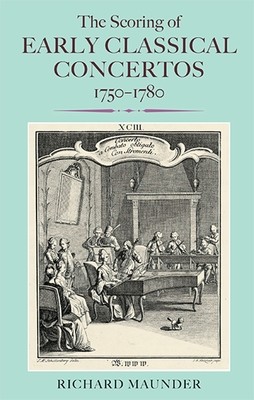
- We will send in 10–14 business days.
- Author: Richard Maunder
- Publisher: Boydell Press
- ISBN-10: 1843838931
- ISBN-13: 9781843838937
- Format: 15.6 x 23.4 x 1.9 cm, hardcover
- Language: English
- SAVE -10% with code: EXTRA
The Scoring of Early Classical Concertos, 1750-1780 (e-book) (used book) | bookbook.eu
Reviews
Description
The sequel to Richard Maunder's The Scoring of Baroque Concertos
In the baroque era most concertos were - in the modern sense of the term - chamber music, to be played by a small group of musicians each reading from an individual printed or manuscript part. Indeed, composers often expected thesoloist to be accompanied by just a string quartet with a harpsichord or organ continuo. But over the thirty years from 1750, as the classical style was being developed, numbers began to rise slowly. This did not happen at a uniform rate throughout Europe, however, for many concertos continued to be played one-to-a-part, and even by 1780 an ensemble with more than eight or nine strings would have been unusual. The nineteenth-century notion that a concertopitted a lone soloist against a full symphony orchestra still lay some years in the future.At the same time ideas about form were changing, as the Vivaldian ritornello pattern metamorphosed into the concerto-sonata form usedby Mozart and his contemporaries; some unconventional variants appeared as composers strove to keep abreast of latest developments. It was a fascinating period of innovation, in which many hundreds of concertos were written. To be sure, not all of them can be described as "forgotten masterpieces", but among them there are some very fine works that certainly ought to be revived. It is hoped that readers of this book may be encouraged to explore this comparatively neglected repertoire. The late RICHARD MAUNDER was a Fellow of Christ's College, Cambridge. His previous book, The Scoring of Baroque Concertos, was published by The Boydell Press in 2004. He has also published books on Mozart's Requiem, Keyboard Instruments in Eighteenth-Century Vienna and numerous editions of seventeenth- and eighteenth-century music.
EXTRA 10 % discount with code: EXTRA
The promotion ends in 20d.23:32:45
The discount code is valid when purchasing from 10 €. Discounts do not stack.
- Author: Richard Maunder
- Publisher: Boydell Press
- ISBN-10: 1843838931
- ISBN-13: 9781843838937
- Format: 15.6 x 23.4 x 1.9 cm, hardcover
- Language: English English
The sequel to Richard Maunder's The Scoring of Baroque Concertos
In the baroque era most concertos were - in the modern sense of the term - chamber music, to be played by a small group of musicians each reading from an individual printed or manuscript part. Indeed, composers often expected thesoloist to be accompanied by just a string quartet with a harpsichord or organ continuo. But over the thirty years from 1750, as the classical style was being developed, numbers began to rise slowly. This did not happen at a uniform rate throughout Europe, however, for many concertos continued to be played one-to-a-part, and even by 1780 an ensemble with more than eight or nine strings would have been unusual. The nineteenth-century notion that a concertopitted a lone soloist against a full symphony orchestra still lay some years in the future.At the same time ideas about form were changing, as the Vivaldian ritornello pattern metamorphosed into the concerto-sonata form usedby Mozart and his contemporaries; some unconventional variants appeared as composers strove to keep abreast of latest developments. It was a fascinating period of innovation, in which many hundreds of concertos were written. To be sure, not all of them can be described as "forgotten masterpieces", but among them there are some very fine works that certainly ought to be revived. It is hoped that readers of this book may be encouraged to explore this comparatively neglected repertoire. The late RICHARD MAUNDER was a Fellow of Christ's College, Cambridge. His previous book, The Scoring of Baroque Concertos, was published by The Boydell Press in 2004. He has also published books on Mozart's Requiem, Keyboard Instruments in Eighteenth-Century Vienna and numerous editions of seventeenth- and eighteenth-century music.


Reviews